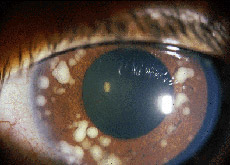Blind patient gets “bionic eye” implant

Swiss doctors have successfully fitted a blind patient with a tiny electronic eye implant to help restore their sight – a European first.
The device uses a camera mounted on a pair of glasses to feed visual information to electrodes in the eye, allowing the patient to see light, shapes and movement.
“It’s close to science fiction,” Avinoam Safran, head of the ophthalmology department at Geneva’s University Hospital, told swissinfo.
“Ten years ago we couldn’t have imagined attaining such a high degree of technology: the conception of the chip, the extraordinary miniaturization and capacity to reconstitute such complex nervous tissue as this part of the retina.”
The retina is a thin layer of cells that are part of the central nervous system. It lines the back of the eyeball, transforming light into electrical impulses the brain can interpret, and can be compared to film in a camera.
Retinal implants can help partially restore the vision of people who suffer from certain hereditary forms of blindness caused by diseases. Among these is retinitis pigmentosa, which affects about 1.5 million people worldwide and causes the retinal cells which process light at the back of the eye to gradually die.
The intricate medical process involved securing the implant – a cluster of 60 electrodes a quarter the size of a postage stamp – to the back of the retina with a micro-tack. But it doesn’t work alone.
A camera mounted on a pair of glasses is used to capture images, and a processing unit, the size of a small handheld computer and worn on a belt, converts the visual information into electrical signals.
The images are then transmitted back to the glasses and to a receiver near the front of the eye, which in turn sends them to the electrodes at the rear, which generate electrical pulses.
These pulses induce responses in the retina that travel through the optic nerve to the brain, which perceives patterns of light and dark spots corresponding to the stimulated electrodes. All this happens in real time.
For patients, the main difficulty is then to learn how to interpret the visual patterns produced into meaningful images.
Visual autonomy
Although it is unlikely a blind person will be able to fully restore their vision using this technique for a very long time, progress has been swift, said Safran.
“We are able to give a blind person the possibility to reconstitute a certain degree of visual autonomy so they can recognise shapes, objects and places, and to be able to move around more easily in the street,” he added.
The quality of a patient’s vision depends largely though on the condition of the eye and the degree of refinement of the device.
The Swiss team of doctors, which carried out the operation last week, were assisted by colleagues in Los Angeles and Paris. It is the first time the operation has been performed in Europe; there have been ten other such operations worldwide.
The Argus II retinal device, which was used in the Geneva operation, is designed by US company Second Sight and costs around $30,000 (SFr32,880). The implant should remain in place for around three years.
In the near future, a patient should be able to enjoy further improvements in their vision thanks to new devices with better resolution via a greater concentration of electrodes, and easier techniques for inserting implants.
“It’s like the development of the aeroplane,” said Safran. “You start with a simple propeller plane and then ten or 20 years later you have the jet. Many things can be improved through technical developments and experience acquired from previous generations of devices.”
swissinfo, Simon Bradley in Geneva
The Swiss National Association of and for the Blind estimates that there are around 80,000–100,000 visually impaired people in Switzerland.
The number of people looked after by organisations for the visually impaired is probably between 10,000 and 20,000. Of these around 10% are blind.
A study by the University of St Gallen shows that there are fewer visually impaired people in the under-44 age group and more in the older population. According to internal surveys among the organisations for the visually impaired, 8–10% of all visually impaired people are over 74 years old.
The most common cause of visual impairment is the natural aging process. In the case of so-called age-related macular degeneration, sight declines in the centre of the field of vision, making reading difficult or impossible; however, there is no need to fear total blindness.
Other causes of visual impairment are accidents or illnesses such as diabetes, cataracts and glaucoma, retinal diseases und congenital conditions.

In compliance with the JTI standards
More: SWI swissinfo.ch certified by the Journalism Trust Initiative












You can find an overview of ongoing debates with our journalists here . Please join us!
If you want to start a conversation about a topic raised in this article or want to report factual errors, email us at english@swissinfo.ch.